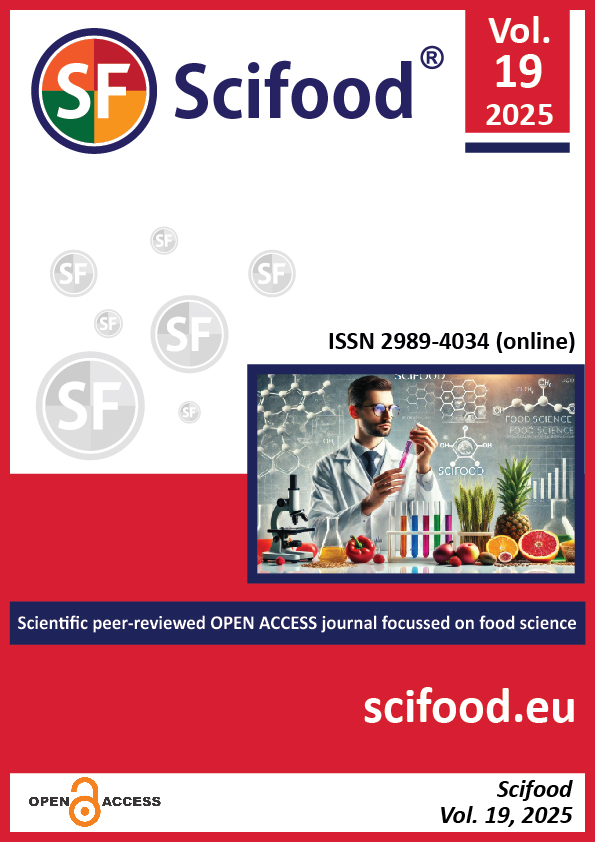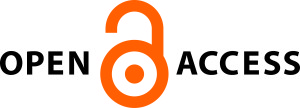Global and regional trends in public interest in cola and energy drinks across English-speaking countries
DOI:
https://doi.org/10.5219/scifood.34Keywords:
Google search volumes, Spearman correlation coefficient, cola, energy drinks, public interestAbstract
A Google-linked plugin was used to investigate the trend in the public’s interest in cola and energy drinks. Seven English-speaking countries and the global context were studied for the time period between 2004 and 2022. The influence of time, the financial income situation in a given country, and the level of human development were investigated as potential independent variables concerning the population's interest in cola and energy drinks. The results of the current study indicate differences in interest in cola drinks and energy drinks among the populations of the seven English-speaking countries studied here. There are also differences between the country-specific context and the global one concerning the population’s interest in cola and energy drinks. Cola drinks are decreasing in significance as a topic of Google searches in Australia, India, South Africa, New Zealand, the United Kingdom, the United States, and Canada. A slightly different trend was observed for energy drinks, where the countries’ populations seem to search for specific brand names rather than general information related to energy drinks. The health impacts of energy drinks are of interest to the populations in the studied countries and globally. Therefore, it is likely that the public searching on Google will receive health promotion interventions related to energy drinks positively. Results from this study can form the foundation for public health approaches tackling the risk factors of non-communicable diseases in the studied countries and South Africa. Future studies should focus on a comparative analysis of public health policies and legislation in addressing the consumption of cola and energy drinks as a potential risk factor for non-communicable diseases in the studied countries and in the global context.
References
1. Mphahlele, K. S., Ngqwala, N. P., Ambang, O. A., Srinivas, C. S., & Tandlich, R. (2023). Health risks associated with the chronic consumption of energy drinks in children and adolescents. Nova Biotechnologica et Chimica Article number e1344. https://doi.org/10.34135/nbc.1344
2. Manyeneng, L. G., & Pilusa, M. L. (2024). Prevalence of fatigue and consumption of energy drinks consumption among nursing students studying part-time. Health SA Gesondheid 29: Article number a2487. https://doi.org/10.4102/hsag.v29i0.2487
3. Fernandes, L., Mokwena, K., & Ntuli, B. (2020). Case report on energy drink consumption among Health Sciences University students in Gauteng Province, South Africa. Public Health Reviews, 41(1). https://doi.org/10.1186/s40985-020-00129-2
4. Chu, B. (2020). Analysis on the Success of Coca-Cola Marketing Strategy. In Advances in Economics, Business and Management Research. 2020 2nd International Conference on Economic Management and Cultural Industry (ICEMCI 2020). Atlantis Press. https://doi.org/10.2991/aebmr.k.201128.019
5. Byala, S. (2023). All that sparkles how Coca-Cola established a foothold in South Africa (Chapter 1). In: Bottled: How Coca-Cola Became African. Oxford University Press, Oxford, United Kingdom (ISBN 978-0197758427), pp. 21-50. https://doi.org/10.1093/oso/9780197758427.003.0002
6. Byala, S. (2023). Know your country how Coca-Cola branded a continent and itself (Chapter 3). In: Bottled: How Coca-Cola Became African. Oxford University Press, Oxford, United Kingdom (ISBN 978-0197758427), pp. 81-112. https://doi.org/10.1093/oso/9780197758427.003.0004
7. Ahmed, R. R., Streimikiene, D., Berchtold, G., Vveinhardt, J., Channar, Z. A., & Soomro, R. H. (2019). Effectiveness of Online Digital Media Advertising as A Strategic Tool for Building Brand Sustainability: Evidence from FMCGs and Services Sectors of Pakistan. Sustainability 11(12): Article number 3436. https://doi.org/10.3390/su11123436
8. Statista (2001-2024). Advertising revenue of Google from 2001 to 2024 (in billion U.S. dollars). Available at: https://www.statista.com/statistics/266249/advertising-revenue-of-google/ (website accessed on 9th March 2025).
9. Madikizela, P., Limson, J., Fogel, R., Ristvej, J., & Tandlich, R. (2024). A tool for the assessment of the risk drivers and public perception of WASH in South Africa. Jàmbá: Journal of Disaster Risk Studies 16(2): Article number a1782. https://doi.org/10.4102/jamba.v16i2.1782
10. Pretorius, A., Kruger, E., & Bezuidenhout, S. (2021). Google trends and water conservation awareness: the internet’s contribution in South Africa. South African Geographical Journal, 104(1), 53–69. https://doi.org/10.1080/03736245.2021.1901239
11. Hammer, O., Harper, D. A.T., & Ryan, P. D. (2001). PAST: Paleontological Statistics Software Package for Education and Data Analysis. Palaeontologia Electronica 4(1):1-9.
12. World Bank (WB, 2022). GNI per capita, PPP (current international $). Available at: https://data.worldbank.org/indicator/NY.GNP.PCAP.PP.CD (website accessed on 24th November 2022).
13. Pratama A.R. & Al-Shaikh, M. (2012). Relation and Growth of Internet Penetration Rate with Human Development Level from 2000 to 2010. Communications of the IBIMA 2012: ID 778309. https://doi.org/10.5171/2012.778309
14. United Nations Human Development Reports (UNHDR, 2004-present). Human Development Index (HDI) – ranks and country information. Available at: https://hdr.undp.org/data-center/human-development-index#/indicies/HDI and https://hdr.undp.org/data-center/country-insights#/ranks (website accessed on 24th November 2022).
15. Commissaries (2021) Coca-Cola Recalls Coca-Cola and Sprite12-oz Cans Due to the Potential Presence of Foreign Matter, Commissaries. Available at: https://www.commissaries.com/our-agency/newsroom/news-releases/coca-cola-recalls-coca-cola-and-sprite12-oz-cans-due-potential (website accessed on 18th March 2025).
16. Food Safety Network (2021) Minute Maid products recalled in 8 states because of metal pieces, Food Safety News. Available at: https://www.foodsafetynews.com/2021/12/minute-maid-products-recalled-in-8-states-because-of-metal-pieces/ (website accessed on 18th March 2025).
17. Food Safety Network (2023) Coca Cola Ultimate recalled after being incorrectly labeled as Zero Sugar, Food Safety News. Available at: https://www.foodsafetynews.com/2023/07/coca-cola-ultimate-recalled-after-being-incorrectly-labeled-as-zero-sugar/ (website accessed on 18th March 2025).
18. Coca Cola (2021) Updated Statement on Appletiser Product Recall, APPLETISER VOLUNTARY PRODUCT RECALL STATEMENT. Available at: https://www.coca-cola.com/za/en/media-center/updated-statement-on-appletiser-product-withdrawal (website accessed on 18th March 2025).
19. Green Cola (2020) Our Story, Green Cola. Available at: https://us.greencola.com/about-green-cola/ (website accessed on 18th March 2025).
20. Ditshwane, B., Janse van Rensburg, Z., & Jacobs, W. (2024). Health-related word recognition and pronunciation by patients in Gauteng, South Africa in English and native languages. African Journal of Primary Health Care & Family Medicine, 16(1). https://doi.org/10.4102/phcfm.v16i1.4492
21. Pascoe, M., Mahura, O., & Dean, J. (2020). Health resources for South Africa: A scoping review. Health SA Gesondheid, 25. https://doi.org/10.4102/hsag.v25i0.1378
22. New Zealand Government (2004-2025). Water is the better choice. Available at: https://order.healthpromotion.govt.nz/products/water-is-the-best-choice (website accessed on 19th March 2025).
23. New Zeland Government (2003-2025). Available at: https://www.health.govt.nz/system/files/2011-11/heha-strategicframework.pdf (website accessed on 19th March 2025).
24. Roomaney, R. A., van Wyk, B., Cois, A., & Pillay-van Wyk, V. (2022). Inequity in the Distribution of Non-Communicable Disease Multimorbidity in Adults in South Africa: An Analysis of Prevalence and Patterns. International Journal of Public Health, 67. https://doi.org/10.3389/ijph.2022.1605072
25. Manning, K., Senekal, M., & Harbron, J. (2016). Non-communicable disease risk factors and treatment preference of obese patients in Cape Town. African Journal of Primary Health Care & Family Medicine, 8(1). https://doi.org/10.4102/phcfm.v8i1.913
26. Kaur, A., Yousuf, H., Ramgobin-Marshall, D., Jain, R., & Jain, R. (2022). Energy drink consumption: a rising public health issue. Reviews in Cardiovascular Medicine, 23(3). https://doi.org/10.31083/j.rcm2303083
27. Anderer, S. (2025). Sweetened Beverages Linked to Millions of Global Diabetes and Heart Disease Cases. JAMA, 333(9), 747. https://doi.org/10.1001/jama.2024.28816
28. South African Revenue Service (2025) Health Promotion Levy on Sugary Beverages https://www.sars.gov.za/customs-and-excise/excise/health-promotion-levy-on-sugary-beverages/ (website accessed on 26th March 2025).
29. Altman, E. A., Madsen, K. A., & Schmidt, L. A. (2021). Missed Opportunities: The Need to Promote Public Knowledge and Awareness of Sugar-Sweetened Beverage Taxes. International Journal of Environmental Research and Public Health, 18(9), 4607. https://doi.org/10.3390/ijerph18094607
30. Lobstein, T. (2025) World Health Organisation: Reducing consumption of sugar-sweetened beverages to reduce the risk of childhood overweight and obesity Available at: https://www.who.int/tools/elena/bbc/ssbs-childhood-obesity (website accessed on 26th March 2025).
31. Mahat, K., & Thapa, B. (2019). Multi-sectoral Approach to Non-Communicable Diseases Control: Easier Said than Done. Journal of Nepal Medical Association, 57(220). https://doi.org/10.31729/jnma.4729
32. Covello, V. T. (2006). Risk communication and message mapping: A new tool for communicating effectively in public health emergencies and disasters. Journal of Emergency Management, 4(3), 25–40. https://doi.org/10.5055/jem.2006.0030
33. Dowse, R., Okeyo, S., Sikhondze, S., & Khumalo, N. (2023). Pharmaceutical indication pictograms for low literacy viewers: Health literacy and comprehension. Health SA Gesondheid, 28. https://doi.org/10.4102/hsag.v28i0.2192
34. Federal Emergency Management Agency of the United States (20Model of strategic communication in emergency situations. Available at and extracted from: https://emilms.fema.gov/is_0029a/curriculum/1.html (slide 80; no copyright applies as far as the auhtoes are aware; website accessed on 7th July 2025).
35. South African National Health Act no. 61 of 2003 (SANHC, 2003-present). Available at: https://www.up.ac.za/media/shared/12/ZP_Files/health-act.zp122778.pdf (website accessed on 7th July 2025).
36. Mukhovha, W., Sibiya, N., Kisten, T., Mamabolo, M. K., & Dlamini, S. N. (2025). Over half of South African beverages will require warning labels for high sugar and/or artificial sweeteners. South African Journal of Clinical Nutrition, 38(1), 31–36. https://doi.org/10.1080/16070658.2025.2453768
37. Naidoo, S. (2013). IV. Oral health and nutrition for children under five years of age: a paediatric food-based dietary guideline. South African Journal of Clinical Nutrition, 26(S), S150-S155.
38. Nakhooda, R., & Wiles, N. (2018). Consumption of added sugars among undergraduate students at a South African university and its association with BMI. South African Journal of Clinical Nutrition, 33(3), 64–71. https://doi.org/10.1080/16070658.2018.1553360
39. Vhiriri, E. P., Laubscher, R., Irwin, Y., & Tandlich, R. (2023). Roles of public service and private stakeholders in the 2017-2018 listeriosis epidemic in South Africa: An ethical conjecture. Journal of Emergency Management, 21(8), 145–162. https://doi.org/10.5055/jem.0711
Downloads
Published
Issue
Section
License
Copyright (c) 2025 Katlego Sharon Mphahlele, Roman Tandlich (Author)

This work is licensed under a Creative Commons Attribution-NonCommercial-NoDerivatives 4.0 International License.
This license permits non-commercial re-use, distribution, and reproduction in any medium, provided the original work is properly cited, and is not altered, transformed, or built upon in any way.














